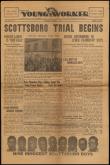Activate: Media
Artists and designers have long responded to social and political events to express their personal feelings and opinions or to promote the agenda of the media, a political movement, or other organization. Often these images have addressed the rights protected in the U.S. Constitution, such as the freedom of speech, the right to a fair trial, or the right to organize and appeal for legal change.
An event that began in 1930—known as “The Scottsboro Boys Trials”—was just such a provocation. Reflecting the racial injustice common in the United States at the time, the case was often sensationalized in the news media and was adopted as a cause for change by the International Labor Defense (or ILD, which was founded by The Communist Party USA in 1925.) The focus of this lesson is on a book entitled Scottsboro: A Story in Block Prints, which is part of The Wolfsonian collection.
Depending on time, you may choose to focus on either the whole book of linocuts or select several images to use in the lesson below. They may be downloaded and printed out or projected for a group discussion.
- Allow students to arrive at their own conclusions about the image by facilitating an open group discussion using the Visual Thinking Strategies© methodology:
- What’s going on in this picture?
- What do you see that makes you say that?
- What more can we find?
- What social or political events today are being addressed on magazine covers? (You may want to do a Google search for magazine covers for labor and politics to have some examples to show. Examples include: Time Magazine Person of the year 2011, “The Protester,” cover.)
- After the group discussion, place students into small groups of 3-4.
- Download, distribute, and circulate copies of the linocuts and covers from the website; or you may provide the link to the website for students to view images online or project them in your classroom.
- Each group will then design a poster or artwork on an approximately 12 x 18 inches poster board (or roughly one-half of a board), collaging images and texts to convey a message about a trial, labor or political conflict, or human or civil rights event/issue in the news today. Distribute the Poster Design Rubric to each group for review as they begin their design process.
- Each group will make an in-class presentation about the artwork they designed explaining the choices they made in terms of topic it is addressing and their use of text, fonts, images, and colors.
- The class should vote on the most successful artworks to be uploaded to Interact section of website. (You will need to request to set up a Community Group before images can be uploaded.)
NOTE: Use the second question to prompt students when they do not provide evidence for their reasoning; for example, “What do you see that makes you say that the man looks sad?”
After this discussion, IF students request more information, you can provide some historical background on the creation of these linocuts.



![Book, Scottsboro: A Story in Block Prints, 1933. Designed by Lin Shi Khan [and] Ralph Austin.](../../sites/default/files/imagecache/110/83.2.2295.000.jpg)